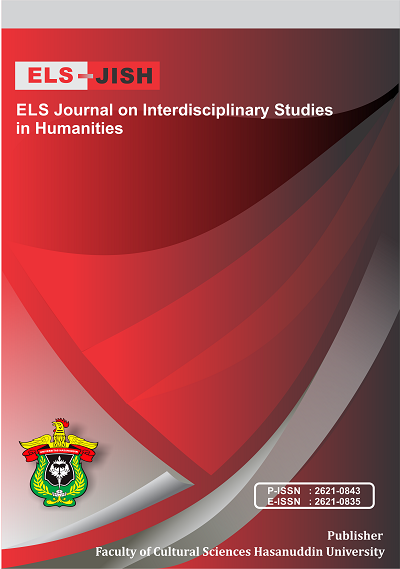Workshop Writing in Composing Paragraph to Improve Students' Writing Skills at SMA Negeri 1 Sampolawa'S Eighth Grade
DOI:
https://doi.org/10.34050/elsjish.v7i3.40177Keywords:
Collaborative, Students, Writing skillAbstract
The purpose of this study was to determine whether or not using collaborative writing to compose paragraphs improves students' writing abilities at SMA Negeri 1 Sampolawa's VIII grade students. It also sought to determine whether or not using collaborative writing sparks students' interest in writing. An experiment using a quassi design was used in this study. Cluster random sampling was utilized as the sample-taking technique, with two classes out of three being taken. 25 students from the XI IPA-2 class were separated into an experimental group by the researcher. and the XI IPA-1 class, which served as the control group, had 25 students. As a result, 50 students made up the research sample. The test and questionnaire served as the study instrument. The research tool was categorized using multiple methods. Pretest, posttest, and questionnaire were those.The results of this study demonstrated that, following treatment with the collaborative writing approach, students' English writing proficiency increased. Based on the experimental group's pretest mean score of 65.97 and posttest mean score of 77.23. The research's hyphotesis resulted in notable effects. Based on the average student perception score of 3,87—a very high level—it is determined.Downloads
References
Arikunto, S. (2007). Prosedur penelitian: Suatu pendekatan praktik (6th ed.). Rineka Cipta.
Collins, J. (2008). Writing for success: Methods and strategies for effective writing. Learning Express.
Fraenkel, J. R., & Wallen, N. E. (1990). How to design and evaluate research in education (2nd ed.). McGraw-Hill.
Gay, L. R., Mills, G. E., & Airasian, P. (2005). Educational research: Competencies for analysis and applications (8th ed.). Pearson.
Handley, A. (2013). Everybody writes: Your go-to guide to creating ridiculously good content. Wiley.
Hasnia, H., Andini, C. ., Tahir, M. D. ., Hunaeni, H., Zulfikariandi, Z., & MT, M. . (2022). The Ability of 1st Class Students of SMAN 11 Enrekang to Arrange Verbal and Nominal Sentences. ELS Journal on Interdisciplinary Studies in Humanities, 5(3), 539-550. https://doi.org/10.34050/elsjish.v5i3.23171
Hulon, W. (1981). The art of writing: Crafting compelling communication. XYZ Publishing.
Jansen, L. S. (2023). Writing In Engineering: Teaching Higher-Order Writing Techniques To Engineering Students In An Extended Degree Programme (Doctoral dissertation, University of Pretoria).
Junaid, S., Nahdhiyah, N., Dahlan, D., Andini, C., & Muh. Dzulhijjah, A. (2024). The Portrayal of African Woman’s Struggle Reflected in the Novel “How Beautiful We Were” By Imbolo Mbue (2021). ELS Journal on Interdisciplinary Studies in Humanities, 7(2), 275-284. https://doi.org/10.34050/elsjish.v7i2.34882
King, C. (2014). The art of collaborative writing. Collaborative Writing Press.
Levine, M. (2002). A mind at a time: America's top learning expert shows how every child can succeed. Simon & Schuster.
Malecki, W. P. (2023). Rorty’s Kind of Writing: Style, Genre, and Rhetoric. In Handbuch Richard Rorty (pp. 119-136). Wiesbaden: Springer Fachmedien Wiesbaden.
Nordquist, R. (2002). Language and writing systems: The keys to communication. Random House.
Prihandoko, L. A., Anggawirya, A. M., & Rahman, F. (2021, December). Students’ perceptions towards autonomous learners concept in academic writing classes: Sequential mixed-method. In International Joined Conference on Social Science (ICSS 2021) (pp. 487-491). Atlantis Press.
Prihandoko, L. A., Al Ahmad, A. S. M., Fredy, F., & Rahman, F. (2022). Multi-regression analysis of factors influencing perceived academic writing competence (PAWC) of Vocational School Students. OKARA: Jurnal Bahasa dan Sastra, 16(2), 329-348.
Rahman, F., Abbas, A., Hasyim, M., Rahman, F., Abbas, A., & Hasyim, M. (2019). Facebook group as media of learning writing in ESP context: A case study at Hasanuddin University. Asian EFL Journal Research Articles, 26(6.1), 153-167.
Siahaan, S. (2008). The essentials of writing: A practical guide for students and teachers. ABC Educational Press.
Suma, M., Rahman, F., Dalyan, M., Andini, C., & Wajadi, A. M. F. (2024). Cultural Aspects of Character Education found in Comic" Pelayaran Ke Dusung": An Ecranization through the Application of Augmented Reality. Journal of Ecohumanism, 3(4), 739-753.
Syafira, D. A. (2023). Effective writing strategies: Insights from expert writers. XYZ Publications.
Tarin, S., & Yawiloeng, R. (2023). The Effects of Using Mind Maps to Enhance EFL Learners’ L2 Writing Development (Doctoral dissertation, University of Phayao).
Yaumi, M. T. A. H., Rahman, F., & Sahib, H. (2024). Bridging Language and Technology through Semiotic Technology. International Journal of Social Science Research and Review, 7(1), 52-61.
Yaumi, M. T. A. H., Rahman, F., & Sahib, H. (2023). Exploring WhatsApp as Teaching and Learning Activities during Covid-19/New Normal era: A Semiotic Technology Analysis. International Journal of Current Science Research and Review, 6(12), 7627-7634.
Downloads
Published
How to Cite
Issue
Section
License
Copyright (c) 2024 Hasrida Ardin, Hikmawati Hikmawati

This work is licensed under a Creative Commons Attribution-ShareAlike 4.0 International License.

















